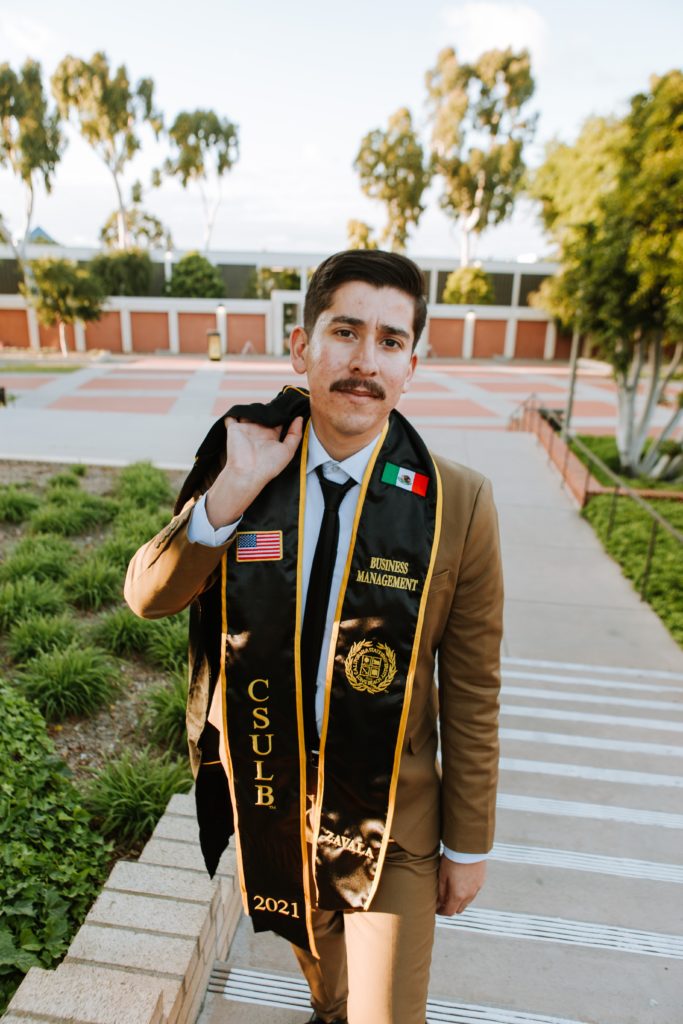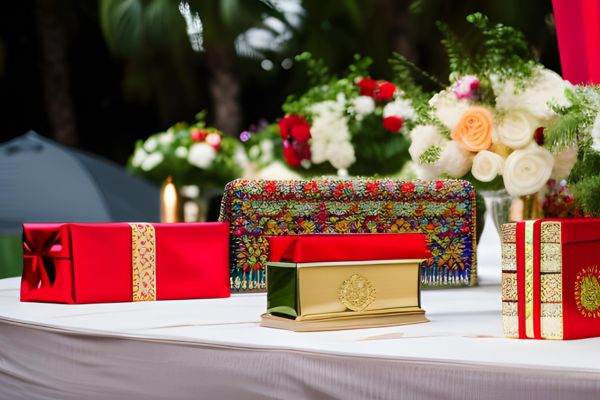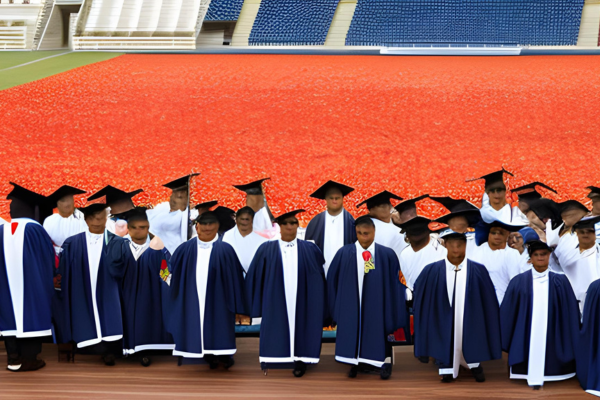Mexican graduation traditions are both colorful and festive. Students typically dress up in traditional costumes and celebrate with family and friends. There are many different graduation traditions in Mexico, but all are joyous occasions. Read on to learn more about these unique celebrations!
Related Content:
Mexican Wedding Gift Traditions
Table of Contents

Wearing Traditional Costumes
One of the most popular Mexican graduation traditions is for students to dress up in traditional Mexican clothing. The girls usually wear brightly colored dresses called trajes de graduación, while the boys don their best suits. Students often decorate their clothes with colorful sashes and ribbons. During graduation in Mexico, students wear traditional caps and gowns as they receive their diplomas. It’s not uncommon for graduates to wear elaborate headdresses, too!
Celebrating with a Fiesta
Another common Mexican graduation tradition is to celebrate with a big party, or fiesta. Families and friends come together to eat, drink, and dance the night away. It’s not uncommon for fiestas to last well into the early hours of the morning.
Mexican graduation parties are typically filled with delicious food. Guests can expect to find a variety of traditional Mexican dishes, as well as plenty of snacks and sweets. Popular party foods include tamales, enchiladas, quesadillas, and tacos. Of course, there is a chance the new graduates will sip on some tequila.
So there you have it – a few of the most popular Mexican graduation traditions. Whether students are dressing up in traditional clothing, celebrating with a fiesta, or feasting on delicious food, one thing is for sure – these unique celebrations are always full of fun and excitement! One can find a plethora of Mexican graduation party ideas online, including traditional decorations, authentic cuisine, and lively mariachi music.
Gifts and Money

Graduates usually receive gifts and money from their loved ones on this special day. It’s considered good luck to give a graduate a gift of money, so many people take part in this tradition.
Some popular Mexican graduation gifts include books, clothes, jewelry, and other useful items. Many people also like to give the graduate a gift that will help them in their future studies or career. Whatever the gift, it’s sure to be appreciated by the proud graduate!
Unique Graduation Traditions
There are many other unique graduation traditions in Mexico. For example, in some regions it’s common for students to jump over a broom after receiving their diploma. This is said to bring them good luck in the future.
No matter what graduation traditions are followed, Mexican graduation celebrations are always a time to remember!
What is a Latinx Graduation?
A Latinx graduation is a ceremony in which Latinx students receive their diplomas. This includes students of Mexican, Puerto Rican, Cuban, Dominican, and other Central and South American descent. The term “Latinx” is used to encompass all these different cultures and backgrounds.
Latinx graduations are typically very festive occasions. Students dress in traditional clothing, and there is often a big party with food and music. Gifts and money are also common.
Jumping over a broom is one unique tradition that is sometimes practiced at Latinx graduations. This is said to bring the graduate good luck in the future. No matter what traditions are followed, Latinx graduation celebrations are always a time to remember!
Mexican Graduation Dress
The Mexican graduation dress is a brightly colored, traditional dress worn by girls during their graduation ceremony. The dress is usually decorated with sashes and ribbons, and may also include an elaborate headdress.
The Mexican graduation dress is a symbol of the students’ culture and heritage. Wearing this special dress on their big day is a way for the girls to celebrate their Latinx identity.
Mexican Graduation Sash
Mexican graduation sashes (commonly referred to as serape stoles) have grown increasingly popular over time. Crafted from vibrant fabric weavings with vibrant hues and intricate patterns that reflect Mexico’s cultural traditions, Mexican graduation sashes have become worn by students to commemorate academic accomplishments while honoring Latin roots while representing cultural pride; first-generation graduates may use these accessories as symbols of both academic achievement and pride for both Latin roots. Some personalized graduation sashes even bear their names or graduation date on them to make these accessories all the more significant!
What Are Graduation Ceremonies Like In Mexico?

Graduation ceremonies in Mexico are joyous and festive events that mark the end of a student’s academic journey. These ceremonies are typically held in June or July, after the completion of the school year. Students dress up in traditional costumes and celebrate with family and friends. Graduation ceremonies typically involve students receiving their diplomas and celebrating their academic achievements.
The graduation ceremony usually begins with a procession of students, faculty, and guests. The graduates are led by their homeroom teachers, while the faculty and guests follow behind. Once everyone is seated, the ceremony begins with speeches from the school’s principal, faculty, and special guests. These speeches often focus on the graduates’ achievements and offer words of encouragement for their future endeavors.
After the speeches, the graduates are called up one by one to receive their diplomas. They walk across the stage to cheers and applause from their family and friends. Once all the diplomas have been handed out, the ceremony concludes with a performance by the school’s band or choir. Graduation ceremonies in Mexico are a time for celebration and reflection, as students look back on their academic journey and prepare for the next chapter of their lives.
When Does the School Year Run in Mexico?

The school year in Mexico typically runs from the second half of August until the beginning of July. This school year is divided into three terms, with the first term running from August to December, the second term running from January to March, and the third term running from April to July. In addition to the three terms, there are also holidays in December and March, as well as a summer break.
The exact dates of the school year may vary depending on the state and school district. However, the Secretariat of Public Education sets the official school calendar for the entire country. This calendar includes the start and end dates of the school year, as well as the dates for holidays and breaks. The calendar is unlikely to be modified, but it is always a good idea to check back regularly for any updates that may occur.
Overall, the school year in Mexico is a rigorous and structured system that aims to provide students with a well-rounded education. It is important for students and their families to stay informed about the dates of the school year, as well as any holidays or breaks, in order to plan accordingly.
Conclusion
In closing, Mexican and Latinx graduation traditions are always a time to remember! Students dress in traditional clothing, celebrate with a big party, and feast on delicious food. Gifts and money are also common. Jumping over a broom is one unique tradition that is sometimes practiced. No matter what traditions are followed, these graduations are always a time to celebrate!
What are your thoughts on Mexican and Latinx graduation traditions? Do you have any personal experiences with these celebrations?
Frequently Asked Questions
What are some Mexican graduation traditions?
Mexican graduation traditions include wearing traditional costumes, decorating mortarboards, and throwing confetti. Students often wear traditional clothing, such as huipils for girls and guayaberas for boys. They also decorate their mortarboards with flowers, glitter, and other decorations. Finally, at the end of the ceremony, students and their families throw confetti to celebrate their achievements.
What is a quinceañera?
A quinceañera is a traditional Mexican celebration that marks a girl’s transition from childhood to womanhood. This celebration typically takes place when a girl turns 15 years old. It is often celebrated with a religious ceremony, followed by a party with family and friends.
What is a padrino or madrina?
A padrino or madrina is a godparent or sponsor who plays an important role in Mexican celebrations, including graduations and quinceañeras. The padrino or madrina typically helps to finance the celebration and may also provide guidance and support to the celebrant.
What is a Mexican fiesta?
A Mexican fiesta is a celebration that typically includes music, dancing, and food. It is often associated with Mexican culture and traditions, and may be held to celebrate a variety of occasions, including graduations, quinceañeras, and birthdays.
What is a mariachi band?
A mariachi band is a traditional Mexican musical group that typically includes trumpets, violins, guitars, and other instruments. Mariachi music is often associated with Mexican culture and is commonly played at celebrations such as graduations, quinceañeras, and weddings.

